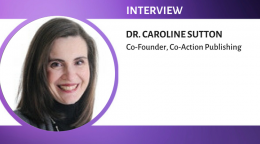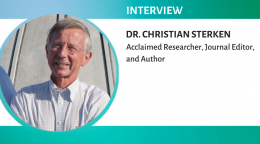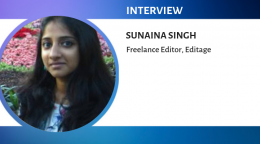The open systems we develop should be inclusive, equitable, and truly serve the needs of a diverse global community

It’s Open Access Week and it’s a great time to discuss some of the most important aspects around the open science concept. I am thrilled to talk to Iryna Kuchma, Open Access Programme Manager for Electronic Information for Libraries (EIFL), a not-for-profit organization that works with libraries to enable access to knowledge in developing and transition economy countries in Africa, Asia Pacific, and Europe. In her current role, Iryna looks into the advocacy of open access to research results, providing support for institutions developing open access policies, setting up, interconnecting, and providing training for working with open access repositories, and organizing workshops and other knowledge sharing events for researchers related to open access. In short, Iryna’s aim is to ensure the practical implementation of the “open” concept especially along the lines of the Horizon 2020 funded projects. Some success stories Iryna has been part of include the establishment of over 1000 open access repositories, 4,000 open access journals and 120 open access policies in EIFL's partner countries. She is also part of the FOSTER and OpenAIRE projects, a member of Directory of Open Access Journals Advisory Board, DSpace Community Advisory Team, and NDLTD (Networked Digital Library of Theses and Dissertations) Board of Directors. In 2013, she received the Electronic Publishing Trust (EPT) for Development Annual Award, in recognition of her “efforts in the furtherance of open access to scholarly publications in the developing and emerging countries.” Iryna has an M.A. in Cultural Studies from the National University ‘Kyiv-Mohyla Academy’, Ukraine.
In this conversation, Iryna shares her views about the state of open access today and her future vision for open science. She elaborates on some of the areas that need greater focus in terms of adopting the “open” concept and discusses some of the biggest impediments to open access in developing countries. She also shares some useful advice for researchers on selecting a legitimate open access journal for their research.
Could you tell us more about EIFL and its mission and vision?
EIFL is a not-for-profit organization that works with over 3,300 libraries in over 40 countries, mostly in the Global South, to enable access to knowledge for education, learning, research, and sustainable community development. Our vision is a world in which all people have the knowledge they need to achieve their full potential.
How does EIFL increase “access to knowledge in developing and transition economy countries”?
Digital technology has revolutionized education and created new opportunities to share information and knowledge, to communicate, and to learn. However, billions of people around the world are still unable to reap the benefits due to issues such as high subscription costs of electronic scholarly content and legal barriers to accessing, using and sharing information, or because they do not have access to technology. EIFL activities aim to address these issues. For example, our Licensing Programme negotiates affordable access to commercial e-resources. Our Copyright and Libraries Programme advocates for a fair national and international copyright system that protects and promotes access to knowledge. Our Open Access Programme enables knowledge sharing. And our Public Library Innovation Programme advances community development by enabling public libraries to implement innovative ideas that use technology to improve people’s lives and livelihoods.
What is the biggest impediment to open access publishing in these countries?
Confusion and misperceptions, complexities of implementations (green, gold and platinum or diamond open access), lack of trust and commitment on institutional and national levels, and lack of digital skills. A particular challenge in our network are Article Processing Charges (APC), which are often high and must be paid in a foreign currency. Poor ICT infrastructure still remains an issue for many countries (although there are a lot of great developments going on now) as well as language barriers in a research world where English is predominantly used and preferred.
You have now been managing EIFL-OA (EIFL’s OA program) for 10 years now and have been part of the FOSTER project. Could you share some highlights from your journey?
EIFL was one of the original signatories for the Budapest Open Access Initiative (BOAI), which first coined the term "Open Access" 16 years ago. And the BOAI vision has framed and supported our work. It was a great privilege to host the very first open access workshops in Kenya, Laos, Malawi, Myanmar, Nigeria, Palestine, Senegal, Uganda, Zimbabwe and many other countries. And it’s exciting to see so many journals, repositories, and policies that our network has been able to facilitate now. Improved visibility of Serbian research using enhanced open access publishing and opening up East African research using open access policies and repositories are among our recent highlights.
In 2009 EIFL joined other organizations in founding Confederation of Open Access Repositories working for a sustainable, global knowledge commons based on a network of open access digital repositories.
EIFL is also a part of the European projects FOSTER – Fostering the practical implementation of open science – and OpenAIRE – Open Access Infrastructure for Research in Europe. It’s great to see the culture change and Europe taking the lead in the open access movement.
How would you describe the development of OA over the years? How do you see the open concept shaping up in the future? Specifically, what trajectory will open access publishing follow?
Open scholarship is growing in importance as a way of ensuring that there is global participation in research, improved quality and efficiency of education and science, and faster economic and social progress.
I was very surprised when the immigration and border control officer at Kathmandu airport asked me about the Directory of Open Access Journals (DOAJ) – a community-curated online directory that indexes and provides access to high quality, open access, peer-reviewed journals – and Nepal Journals Online – a service to provide access to Nepalese published research.
A lot has been achieved already and a lot has been going on now. But I would call it a success, when open access is the mainstream, the norm of scholarly communication, embedded in researchers’ workflows; when most of research outputs available in open access; and when every institution of higher education that offers degree courses, and every research funding agency, have an open access policy in place.
We still need more involvement from key players – in national governments, in research funding agencies, in rectors’ conferences, in publishing companies, at research and educational institutions.
And we still need more involvement and voices from the Global South, where well over half of the world’s population live. Latin America has lots of open access publishing successes and I would like to see such successes in Africa and South-East and South Asia as well.
I would also like to see more collaboration among the open movements – Open Government Partnership Initiatives, open data, free and open source, open innovation and Open Educational Resources (OERs) – and with patient groups and health movements, biomedical (and other) companies practicing text and data mining for research and development.
I strongly believe in collaborations and my vision of successful open access publishing in our regions is collaborative, community-based initiatives using public open e-infrastructures (publicly owned, funded and managed, that can’t be sold), distributed (non-central), interoperable and mostly non-APC based.
In your opinion, what role do libraries play in today’s open access landscape? Also, what are the top challenges librarians face?
In many institutions in our network libraries are the most innovative centers driving new open developments. Libraries are involved in shaping open access policies; they set up and manage open access repositories for publications and data; help to publish open access journals and books and to create OERs; provide research data management support and train researchers on open science. Building digital research skills and moving towards shared infrastructures are the top challenges that libraries face now.
What are some of the best practices for Open Science that various stakeholders in the publishing industry need to adapt today?
Publishers should follow the eight transparency standards covered by the Guidelines for Transparency and Openness Promotion in Journal Policies and Practices - citation standards, data, analytic methods (code), and research materials transparency, design and analysis transparency, preregistration of studies, preregistration of analysis plans and replication. They should also allow preprints sharing to get early feedback on research work. And of course publish open access articles and books. Researchers should retain copyright and try to share as much as possible – starting from research proposals to protocols, workflows, data, software, publications. And institutions and funders should reward researchers for open sharing.
Today, there is literally an influx of academic journals and publishers. In this crowded publishing landscape how can researchers go about choosing the most relevant and reliable open access journal for their paper?
Start with DOAJ that includes over 12,000 journals. Use the 'Think. Check. Submit' checklist to help you assess the quality of the journal you are considering. Only submit your article if you can answer ‘yes’ to most of the questions on the checklist. If you are still not sure about your choice, speak to your supervisor or manager about your publishing options. Librarians and colleagues who focus on scholarly communication issues in your field can also provide useful guidance and advice.
Global discussions during Open Access Week this year will focus specifically on “Designing Equitable Foundations for Open Knowledge.” What are your views on this theme? How can each stakeholder in research and its communication enable the establishment of such an equitable foundation?
As a member of the Open Access Week Advisory Committee I am very proud of this theme. It’s very timely to ensure that open systems we develop are inclusive, equitable, and truly serve the needs of a diverse global community. Researchers, institutions and publishers from the Global South should get more involved in these discussions and articulate their needs and wishes. Funders and publishers from the Global North should remember that the policies they implement should work for all researchers and not only for those who have funding to pay APCs. I very much look forward to the Open Access Week discussions.
Any interesting future plans for EIFL?
We are focusing on four key areas: open access policies, open science training for early career researchers, sustainable open access journals and repositories, and OERs. We need more open access policies in the Global South. Embedding open access, open data and open science in early career researchers’ training is our strategy for achieving the vision “open by default.” We are exploring options for sustainable open access publishing business models, and ways of enhancing open access publishing platforms. And we promote the development of the next generation repositories, with new functionalities and new technologies. Open education is a rather new area for us, but we believe in synergies between the open movements and we are learning from the others as we go.
Thanks for sharing your vision for open science with us, Iryna! Happy Open Access Week to you!
Published on: Oct 23, 2018
Comments
You're looking to give wings to your academic career and publication journey. We like that!
Why don't we give you complete access! Create a free account and get unlimited access to all resources & a vibrant researcher community.







